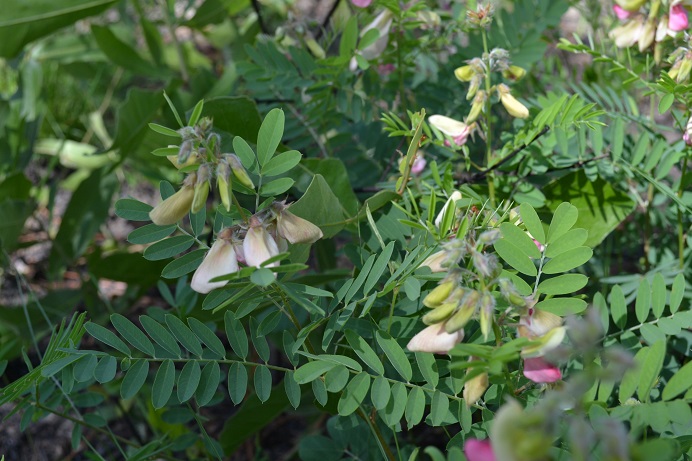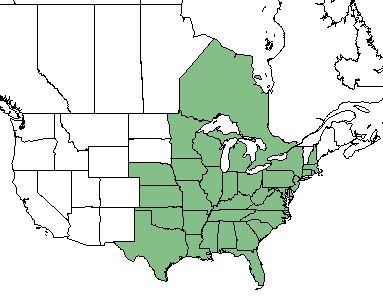Difference between revisions of "Tephrosia virginiana"
Krobertson (talk | contribs) |
Krobertson (talk | contribs) (→Seed bank and germination) |
||
| Line 41: | Line 41: | ||
===Seed bank and germination=== | ===Seed bank and germination=== | ||
| − | This species is thought to be dispersed by gravity. <ref> Kirkman, L. Katherine. Unpublished database of seed dispersal mode of plants found in Coastal Plain longleaf pine-grasslands of the Jones Ecological Research Center, Georgia.</ref> In Georgia, seeds buried in a seed bag for 1 and 2 years | + | This species is thought to be dispersed by gravity. <ref> Kirkman, L. Katherine. Unpublished database of seed dispersal mode of plants found in Coastal Plain longleaf pine-grasslands of the Jones Ecological Research Center, Georgia.</ref> In Georgia, seeds buried in a seed bag for 1 and 2 years showed 61% and 50% germination rates, respectively.<ref name="Coffey & Kirkman 2006">Coffey KL, Kirkman LK (2006) Seed germination strategies of species with restoration potential in a fire-maintained pine savanna. Natural Areas Journal 26(3):289-299.</ref> |
===Fire ecology=== | ===Fire ecology=== | ||
Revision as of 16:57, 21 October 2019
| Tephrosia virginiana | |
|---|---|

| |
| Photo by Kevin Robertson | |
| Scientific classification | |
| Kingdom: | Plantae |
| Division: | Magnoliophyta - Flowering plants |
| Class: | Magnoliopsida - Dicots |
| Order: | Fabales |
| Family: | Fabaceae |
| Genus: | Tephrosia |
| Species: | T. virginiana |
| Binomial name | |
| Tephrosia virginiana (L.) Pers. | |

| |
| Natural range of Tephrosia virginiana from USDA NRCS Plants Database. | |
Common Name(s): Virginia goat's-rue;[1] Virginia tephrosia;[2][3] goat's rue; devil's shoestring[3]
Contents
Taxonomic Notes
Synonyms: T. virginiana var. glabra Nuttall; T. virginiana var. virginiana; Cracca virginiana Linnaeus
Description
Tephrosia virginiana is covered with soft white hairs, which makes it silvery green in appearance. It grows to 1-3 ft (0.30-0.91 m) and has long stringy roots, from which it gets the name devil's shoestring. Leaves are pinnately compound with 8-15 pairs of leaflets. Flowers are bi-colored with pink and pale yellow and typically cluster at the tip of the stem. In southern portions of its range, flowers can initially be white but will change over time.[3] T. virgininana is hard seeded, thus requiring scarification.[4]
Distribution
This species is found from Texas, eastward to Florida, northward to New Hampshire and New York, and inland to Minnesota and Nebraska.[1][2] It is also reported to occur in the Ontario province of Canada.[2]
Ecology
Habitat
T. virginiana is found in sandhill and clayhill longleaf pine communities, other pinelands, xeric or rocky woodlands and forests, outcrops, shale barrens, other barrens, and dry roadbanks.[1] In South Carolina, it was found in 72% of forest sites, 0% of pastures, and 8% of cultivated fields.[5] It is considered a characteristic legume species of shortleaf pine-oak-hickory woodlands[6] and longleaf pine/wiregrass communities.[7] It is considered indicative of non-agricultural history on frequently burned longleaf pine habitats.[8]
T. virginiana has been shown to be negatively associated with post-agricultural pine communities historically dominated by longleaf pine in South Carolina[9][10][11] and southern Georgia[12][13][14] such that it is used a native pine community indicator species in these areas.
In Massachusetts it is one of several species positively associated with Linum intercursum and Scleria pauciflora. [15]
Phenology
T. virginiana has been observed to flower April through June.[1][16] Fruiting occurs from July through October.[1] Germination occurs from March through June when seasonal temperatures are increasing.[17] Flowering is stimulated by fire and occurs within three months of burning.[18]
Seed bank and germination
This species is thought to be dispersed by gravity. [19] In Georgia, seeds buried in a seed bag for 1 and 2 years showed 61% and 50% germination rates, respectively.[17]
Fire ecology
T. virginiana re-sprouts rapidly following fire and flowers within three months of burning.[18] Conversely, flowering is quite limited during years without fire.[20] Burning has also been shown to decrease the percentage of seeds that germinate. However, this is only true when course fuels (e.g. pine cones), and not fine fuels (e.g. pine needles), are consumed. Models suggest these course fuels produce mortality close to the fuel but fails to scarify seeds further away; this leaves an area between the two where scarification and germination can occur.[4] Flowering in response to fire has been shown to vary little between dormant season and late spring/early summer prescribed fires.[20]
Use by animals
T. virginiana comprises 2-5% of the diets of some large mammals and terrestrial birds.[21] Common grasshoppers, including Melanopus angustipennis and grasshoppers in the subfamilies Melanoplinae and Cyrtacanthacridinae, are mixed feeders and found to feed on this plant. However, herbivory did not affect overall biomass or mortality of the plant.[8] In the past, it was used as a goat feed to increase milk production. However, this use stopped after tephrosin, an insecticide and fish poison, was found in it.[3]
Conservation and Management
Cultivation and restoration
Seeds can be collected from August to September. Seeds should be scarified, inoculated, and moist stratified for ten days to stimulate germination.[3]
Photo Gallery
References and notes
- ↑ 1.0 1.1 1.2 1.3 1.4 Weakley A. S.(2015). Flora of the Southern and Mid-Atlantic States. Chapel Hill, NC: University of North Carolina Herbarium.
- ↑ 2.0 2.1 2.2 USDA, NRCS. (2016). The PLANTS Database (http://plants.usda.gov, 12 January 2018). National Plant Data Team, Greensboro, NC 27401-4901 USA.
- ↑ 3.0 3.1 3.2 3.3 3.4 Plant database: Tephrosia virginiana. (12 January 2018) Lady Bird Johnson Wildflower Center. URL: https://www.wildflower.org/plants/result.php?id_plant=TEVI
- ↑ 4.0 4.1 Wiggers MS, Kirkman LK, Boyd RS, Hiers JK (2013) Fine-scale variation in surface fire environment and legume germination in the longleaf pine ecosystem. Forest Ecology and Management 310:54-63.
- ↑ Brudvig LA, Damschen EI (2011) Land-use history, historical connectivity, and land management interact to determine longleaf pine woodland understory richness and composition. Ecography 34:257-266.
- ↑ Clewell AF (2013) Prior prevalence of shortleaf pine-oak-hickory woodlands in the Tallahassee red hills. Castanea 78(4):266-276.
- ↑ Andreu MG, Hedman CW, Friedman MH, Andreu AG (2009) Can managers bank on seed banks when restoring Pinus taeda L. plantations in southwest Georgia? Restoration Ecology 17(5):586-596.
- ↑ 8.0 8.1 Hahn, P. C. and J. L. Orrock (2015). "Land-use legacies and present fire regimes interact to mediate herbivory by altering the neighboring plant community." Oikos 124: 497-506.
- ↑ Brudvig, L.A. and E.I. Damchen. (2011). Land-use history, historical connectivity, and land management interact to determine longleaf pine woodland understory richness and composition. Ecography 34: 257-266.
- ↑ Brudvig, L.A., E Grman, C.W. Habeck, and J.A. Ledvina. (2013). Strong legacy of agricultural land use on soils and understory plant communities in longleaf pine woodlands. Forest Ecology and Management 310: 944-955.
- ↑ Brudvig, L.A., J.L. Orrock, E.I. Damschen, C.D. Collins, P.G. Hahn, W.B. Mattingly, J.W. Veldman, and J.L. Walker. (2014). Land-Use History and Contemporary Management Inform an Ecological Reference Model for Longleaf Pine Woodland Understory Plant Communities. PLoS ONE 9(1): e86604.
- ↑ Hedman, C.W., S.L. Grace, and S.E. King. (2000). Vegetation composition and structure of southern coastal plain pine forests: an ecological comparison. Forest Ecology and Management 134:233-247.
- ↑ Kirkman, L.K., K.L. Coffey, R.J. Mitchell, and E.B. Moser. Ground Cover Recovery Patterns and Life-History Traits: Implications for Restoration Obstacles and Opportunities in a Species-Rich Savanna. (2004). Journal of Ecology 92(3):409-421.
- ↑ Ostertag, T. E. and K. M. Robertson 2007. A comparison of native versus old-field vegetation in upland pinelands managed with frequent fire, South Georgia, USA. Tall Timbers Fire Ecology Conference Proceedings 23:109-120.
- ↑ Clarke GL, Patterson WA III (2007) The distribution of disturbance-dependent rare plants in a coastal Massachusetts sandplain: Implications for conservation and management. Biological Conservation 136:4-16.
- ↑ Nelson, G. PanFlora: Plant data for the eastern United States with emphasis on the Southeastern Coastal Plains, Florida, and the Florida Panhandle. www.gilnelson.com/PanFlora/ Accessed: 12 JAN 2018
- ↑ 17.0 17.1 Coffey KL, Kirkman LK (2006) Seed germination strategies of species with restoration potential in a fire-maintained pine savanna. Natural Areas Journal 26(3):289-299.
- ↑ 18.0 18.1 Robertson, K. 2015. personal observation at Pebble Hill Fire Plots, Pebble Hill Plantation, near Thomasville, Georgia.
- ↑ Kirkman, L. Katherine. Unpublished database of seed dispersal mode of plants found in Coastal Plain longleaf pine-grasslands of the Jones Ecological Research Center, Georgia.
- ↑ 20.0 20.1 Hiers, J. K., R. Wyatt and R. J. Mitchell 2000. The effects of fire regime on legume reproduction in longeaf pine savannas: is season selective? Oecologia 125:521-530.
- ↑ Miller JH, Miller KV (1999) Forest plants of the southeast and their wildlife uses. Southern Weed Science Society.